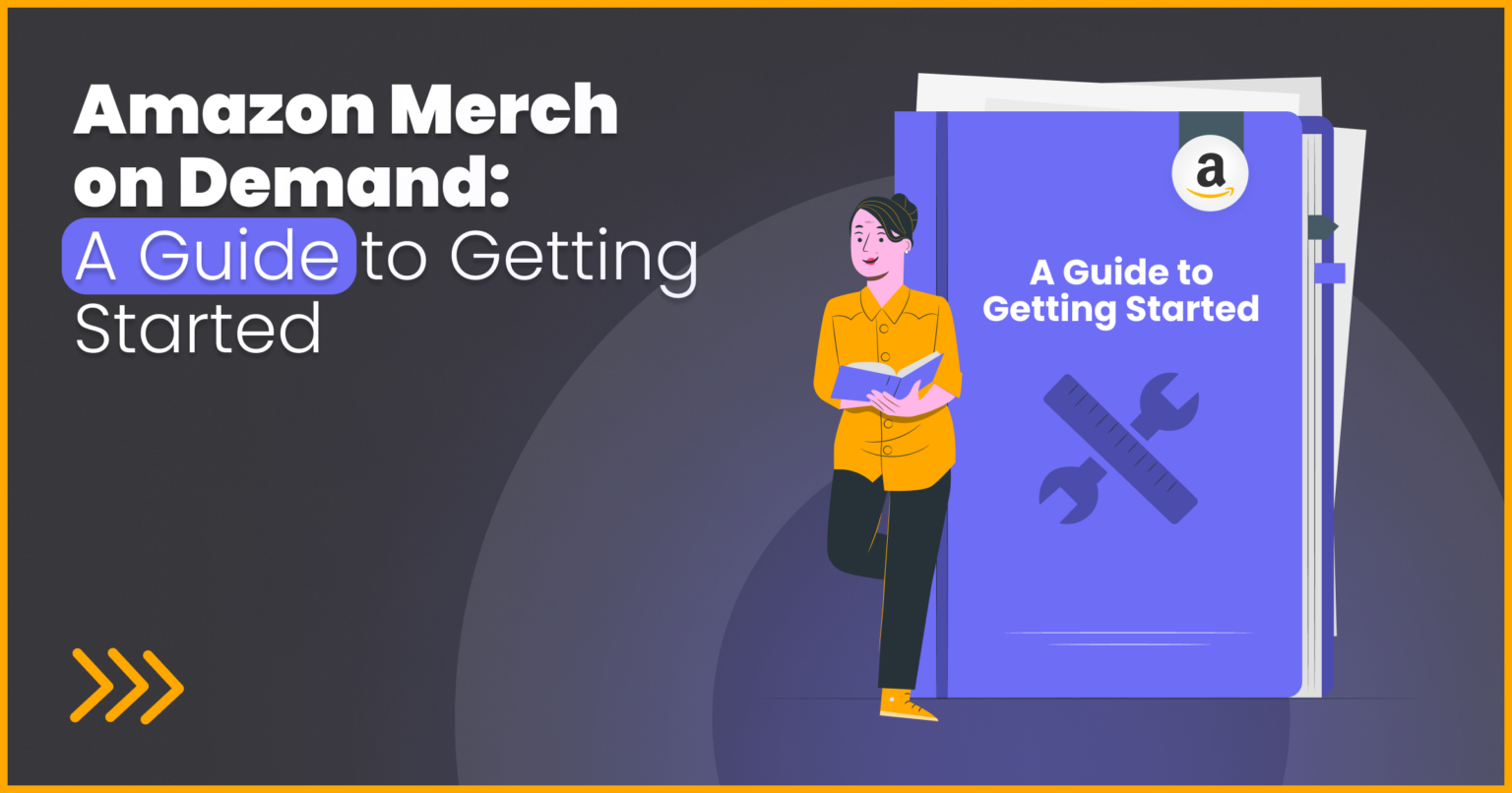Amazon Merch on Demand: A Guide to Getting Started

Welcome to the ultimate guide on leveraging Amazon to sell your books effectively in 2024. In today’s digital age, Amazon has emerged as the premier platform for selling books, offering unparalleled reach and convenience for both sellers and buyers. Whether you’re a seasoned publisher or an aspiring author, mastering the art of selling books on Amazon is crucial for maximizing your revenue potential. In this guide, we’ll delve into the strategies, tactics, and tools you need to succeed in the competitive world of online book sales.
Registering for Amazon Merch on demand
If you’re ready to dive into the world of Amazon Merch on Demand, the first step is to register for the program. In this section, we’ll walk you through the process from account creation to adding banking information, ensuring you’re set up for success every step of the way.
Account Creation
Creating an account for Amazon Merch is quick and straightforward. Simply visit the Amazon Merch website and click on the “Sign Up” or “Get Started” button. You’ll be prompted to provide basic information such as your name, email address, and password. Once you’ve filled out the necessary details, click “Create Account” to proceed.
Waiting for Approval
After you’ve submitted your account information, you’ll need to wait for approval from Amazon. This process can take anywhere from a few days to a few weeks, depending on current demand and other factors. While you’re waiting, take the time to familiarize yourself with the platform and start brainstorming ideas for your merchandise designs.
Adding Banking Information
Once your account is approved, it’s time to add your banking information so you can receive payments for your merchandise sales. Navigate to the “Settings” or “Account Info” section of your Amazon Merch dashboard and look for the option to add your banking details. You’ll likely need to provide information such as your bank account number, routing number, and account holder name.
In some cases, Amazon may require additional verification to ensure the security of your account. This may involve providing documentation such as a driver’s license or passport to confirm your identity. Follow the instructions provided by Amazon to complete the verification process promptly.
Once you’ve completed these steps, you’re officially ready to start selling your merchandise on Amazon Merch! Begin by uploading your designs, setting your prices, and optimizing your listings for maximum visibility. Keep an eye on your sales dashboard to track your progress and make adjustments as needed to maximize your success on the platform.
Registering for Amazon Merch is a straightforward process that opens up a world of opportunities for authors and publishers to expand their revenue streams and engage with their audience in new and exciting ways. Follow these steps to get started today, and unleash your creativity on the world’s largest online marketplace.
Understanding the Merch-on-Demand Process
In this section, we’ll delve into the ins and outs of the Merch on Demand process, shedding light on what it is and how the print-on-demand (POD) system operates to empower authors and publishers in the digital age.
What is Merch on Demand?
Merch on Demand, also known as Print on Demand (POD), is a revolutionary service offered by Amazon that enables creators to design and sell custom merchandise without the need for upfront investment or inventory management. With Merch on Demand, authors and publishers can leverage the power of Amazon’s vast infrastructure to produce and fulfill orders on a per-demand basis, eliminating the risks and costs associated with traditional manufacturing and distribution methods.
How Does the Print on Demand Process Work?
The print on demand process operates on a simple yet powerful principle: produce items only when they’re ordered. Here’s a step-by-step breakdown of how it works:
- Design Creation: Authors and publishers create designs for their merchandise, which can include anything from book cover art and quotes to logos and illustrations. These designs are typically created digitally using design software or outsourced to professional designers.
- Product Selection: Once the designs are ready, creators select the products they want to offer, such as t-shirts, hoodies, mugs, and more. Amazon provides a range of product options to choose from, allowing creators to tailor their merchandise offerings to their audience’s preferences.
- Listing Creation: Creators then upload their designs and create product listings on the Amazon Merch platform. This involves adding product titles, descriptions, and images to showcase the merchandise effectively to potential buyers.
- Order Placement: When a customer places an order for a product, Amazon’s system automatically processes the order and sends it to the printing facility nearest to the customer’s location.
- Printing and Fulfillment: The printing facility receives the order and produces the merchandise using the uploaded design. Once the items are printed, they’re packaged and shipped directly to the customer’s address.
- Payment and Reporting: Amazon handles all payment processing and provides creators with detailed reports on their sales and earnings. Creators receive a portion of the revenue from each sale, with Amazon deducting the production and fulfillment costs.
- Customer Satisfaction: Customers receive their merchandise promptly and can enjoy high-quality products featuring the designs they love. Amazon’s reputation for reliability and customer service ensures a positive shopping experience for buyers.
The print on demand process offers a seamless and efficient way for authors and publishers to create and sell custom merchandise without the hassle of traditional manufacturing and distribution. By leveraging Amazon’s vast resources and infrastructure, creators can focus on what they do best—creating compelling designs and engaging with their audience—while Amazon handles the rest.

Creating and Uploading Designs
In this section, we’ll explore the process of creating and uploading designs for your merchandise on the Amazon Merch platform. From understanding design requirements to utilizing tools for design creation and finally, uploading your designs to the platform, we’ll cover everything you need to know to get started.
Understanding Design Requirements
Before diving into the design creation process, it’s essential to understand the design requirements set forth by Amazon Merch. These requirements ensure that your designs meet the platform’s quality standards and are suitable for printing on various merchandise items. Some key considerations include:
- File Format: Amazon typically accepts designs in formats such as PNG or JPEG.
- Resolution: Designs should be high-resolution to ensure crisp printing quality. Aim for at least 300 DPI (dots per inch).
- Color Mode: Designs should be in RGB color mode for optimal printing results.
- Size and Dimensions: Each merchandise item has specific size and dimension requirements for design placement. Be sure to familiarize yourself with these guidelines before creating your designs.
By adhering to these requirements, you can ensure that your designs are compatible with the Amazon Merch platform and meet the expectations of both you and your customers.
Using Tools to Create Designs
Fortunately, you don’t need to be a professional graphic designer to create stunning designs for your merchandise. There are plenty of user-friendly tools and software available that make the design creation process accessible to creators of all skill levels. Some popular options include:
- Adobe Photoshop: A versatile design software with robust features for creating and editing images.
- Canva: An online graphic design platform that offers a wide range of templates and customizable elements.
- Adobe Illustrator: A vector-based design software ideal for creating logos, illustrations, and other scalable graphics.
Explore different tools to find the one that best suits your needs and preferences. Many of these tools offer free or affordable options, making them accessible to creators on any budget.
Uploading Designs to the Platform
Once you’ve created your designs, it’s time to upload them to the Amazon Merch platform. The process is straightforward:
- Log in to your Amazon Merch account and navigate to the “Create” or “Upload” section of the dashboard.
- Select the type of product you’d like to upload your design for (e.g., t-shirts, hoodies, mugs).
- Upload your design file(s) according to the platform’s specifications, ensuring that they meet the required format, resolution, and size.
- Preview your design on the selected merchandise item to ensure it looks as intended.
- Add relevant product details such as titles, descriptions, and keywords to optimize your listings for search visibility.
- Set your pricing and availability preferences for each product variation.
- Submit your design for review and approval by Amazon’s moderation team.
Once your designs are approved, they’ll be available for purchase on the Amazon Merch platform, allowing you to start generating sales and reaching your target audience with your custom merchandise.
Creating and uploading designs for your merchandise on Amazon Merch is an exciting opportunity to unleash your creativity and connect with your audience in new and meaningful ways. By understanding design requirements, utilizing design tools, and following the platform’s upload guidelines, you can showcase your unique style and captivate customers with compelling merchandise offerings.
Optimization of Listings
In this section, we’ll explore the key strategies for optimizing your listings on the Amazon Merch platform to maximize visibility, attract customers, and drive sales. From creating an attractive title and description to selecting keywords and tags, and optimizing preview images, we’ll cover everything you need to know to make your merchandise stand out in the crowded marketplace.
Creating an Attractive Title and Description
The title and description of your merchandise listings play a crucial role in capturing the attention of potential buyers and conveying the value of your products. Here are some tips for creating compelling titles and descriptions:
Be Descriptive: Use descriptive language to communicate what your product is and why it’s worth purchasing. Highlight key features, benefits, and unique selling points.
Include Keywords: Incorporate relevant keywords related to your design, niche, and target audience to improve search visibility and ranking.
Keep it Concise: Keep your title and description concise and to the point. Avoid unnecessary fluff and focus on providing valuable information that helps customers make informed purchasing decisions.
Use Persuasive Language: Use persuasive language to evoke emotion and create a sense of urgency or excitement. Encourage customers to take action by highlighting limited-time offers, discounts, or exclusive promotions.
Selecting Keywords and Tags
Keywords and tags are essential for ensuring your merchandise listings appear in relevant search results and reach your target audience. Here’s how to effectively select keywords and tags for your listings:
Research Keywords: Conduct keyword research to identify relevant terms and phrases that potential customers are likely to use when searching for products similar to yours. Use tools like Google Keyword Planner, Amazon’s search autocomplete feature, and competitor analysis to gather insights.
Focus on Relevance: Choose keywords and tags that accurately reflect the theme, style, and subject matter of your designs. Avoid using generic or overly broad keywords that may attract irrelevant traffic.
Include Long-Tail Keywords: Incorporate long-tail keywords—phrases consisting of three or more words—that are specific to your niche and have lower competition. Long-tail keywords can help you target more qualified leads and improve your chances of ranking higher in search results.
Utilize Variation: Experiment with different keyword variations and combinations to cover a wide range of search queries and capture the attention of different audience segments.
Optimizing Preview Images
The preview images of your merchandise are often the first thing customers see when browsing listings, making them a crucial aspect of optimization. Here are some tips for optimizing your preview images:
High-Quality Images: Use high-resolution images that showcase your designs clearly and accurately. Customers are more likely to be attracted to products with visually appealing images.
Showcase Different Angles: Include multiple images showcasing your design from different angles, perspectives, and close-ups. This allows customers to get a comprehensive view of the product and its details.
Contextual Imagery: Incorporate lifestyle or contextual imagery to help customers envision how they can use or wear your merchandise in real-life situations. This can enhance the appeal of your products and increase the likelihood of purchase.
Consistency: Maintain consistency in your image style, branding, and aesthetics across all listings to create a cohesive and professional storefront that reinforces your brand identity.
By implementing these optimization strategies, you can enhance the visibility, appeal, and effectiveness of your merchandise listings on the Amazon Merch platform, ultimately driving more traffic and sales to your products.
Product Promotion
In this section, we’ll explore effective strategies for promoting your products on the Amazon Merch platform to increase visibility, attract customers, and boost sales. From leveraging social media and participating in communities and forums to optimizing for search engine visibility, we’ll cover key tactics to help you reach your target audience and drive conversions.
Using Social Media for Promotion
Social media platforms offer powerful opportunities to showcase your products, engage with your audience, and drive traffic to your Amazon Merch listings. Here’s how to effectively use social media for product promotion:
Choose the Right Platforms: Identify which social media platforms your target audience frequents the most and focus your efforts on those platforms. Whether it’s Instagram, Facebook, Twitter, or Pinterest, tailor your content and messaging to suit the preferences of each platform’s user base.
Create Compelling Content: Share visually appealing images, videos, and graphics that showcase your merchandise in action. Highlight the unique features, benefits, and value propositions of your products to entice followers and encourage them to click through to your Amazon listings.
Engage with Your Audience: Foster meaningful connections with your audience by responding to comments, messages, and inquiries in a timely and personable manner. Encourage user-generated content by reposting customer photos and testimonials to showcase social proof and build trust.
Run Promotional Campaigns: Leverage social media advertising features to run targeted promotional campaigns that reach specific demographics, interests, and behaviors. Experiment with different ad formats, targeting options, and messaging to optimize your campaign performance and maximize ROI.
Participation in Communities and Forums
Engaging with online communities and forums related to your niche or industry is a valuable way to build relationships, establish credibility, and promote your products indirectly. Here’s how to effectively participate in communities and forums for product promotion:
Join Relevant Groups: Seek out online communities, forums, and discussion groups where your target audience congregates and actively participates in discussions, shares insights, and provides valuable contributions. Avoid overtly promoting your products and focus instead on providing genuine value and building relationships.
Establish Authority: Position yourself as a knowledgeable and trusted authority in your niche by sharing helpful tips, answering questions, and offering solutions to common problems. Contribute meaningful content that demonstrates your expertise and adds value to the community.
Soft Promotion: While direct promotion should be kept to a minimum, subtle mentions of your products or brand can be incorporated naturally into your interactions when relevant. Share success stories, case studies, or behind-the-scenes insights that subtly highlight your products without coming across as sales.
SEO Optimization to Increase Visibility
Search engine optimization (SEO) is crucial for improving the visibility of your Amazon Merch listings and driving organic traffic from search engines like Google. Here are some SEO optimization tips to increase visibility:
Keyword Research: Identify relevant keywords and phrases that potential customers are likely to use when searching for products like yours. Incorporate these keywords strategically into your product titles, descriptions, and bullet points to improve search relevance and visibility.
Optimize Product Titles and Descriptions: Craft compelling and keyword-rich product titles and descriptions that accurately describe your products and highlight their unique features and benefits. Use clear, concise language and include relevant keywords to improve search visibility and click-through rates.
Optimize Image Alt Text: Use descriptive alt text for your product images that include relevant keywords and accurately describe the content of the image. This helps improve accessibility for visually impaired users and provides additional context for search engines.
Encourage Customer Reviews: Positive customer reviews not only improve your credibility and reputation but also play a role in search engine rankings. Encourage satisfied customers to leave reviews by providing excellent customer service, incentivizing reviews with discounts or rewards, and following up with post-purchase emails.
By implementing these strategies, you can effectively promote your products on the Amazon Merch platform, increase visibility, and drive traffic and sales to your listings. Experiment with different tactics, monitor your results and refine your approach over time to optimize your promotional efforts and achieve your business goals.
Tracking and Analyzing Results
Effective tracking and analysis are essential for evaluating the success of your efforts on the Amazon Merch platform and making data-driven decisions to optimize your strategy. In this section, we’ll explore how to monitor sales and reviews, conduct data analysis to improve your strategy, and make informed changes to your designs and listings.

Monitoring Sales and Reviews
Tracking your sales performance and monitoring customer reviews provides valuable insights into the effectiveness of your products and allows you to identify areas for improvement. Here’s how to effectively monitor sales and reviews:
- Sales Dashboard: Regularly check your sales dashboard on the Amazon Merch platform to track key metrics such as units sold, revenue generated, and overall performance. Monitor sales trends over time to identify patterns and opportunities for growth.
- Review Monitoring: Keep a close eye on customer reviews and ratings for your products. Pay attention to both positive and negative feedback, and use it to inform your product development and marketing strategies. Address any customer concerns or issues promptly to maintain a positive reputation and improve customer satisfaction.
Data Analysis to Improve Strategy
Analyzing data is crucial for refining your strategy and optimizing your approach on the Amazon Merch platform. Here are some key data analysis techniques to consider:
- Sales Analysis: Dive deep into your sales data to identify top-performing products, best-selling categories, and emerging trends. Analyze factors such as pricing, seasonality, and customer demographics to optimize your product offerings and pricing strategies.
- Keyword Analysis: Analyze keyword performance and search trends to identify high-performing keywords and optimize your listings for better visibility. Monitor changes in keyword rankings and adjust your keyword strategy accordingly to stay ahead of the competition.
- Traffic Analysis: Track traffic sources and referral sources to your Amazon listings to understand where your customers are coming from and which marketing channels are driving the most traffic and conversions. Use this information to allocate resources effectively and prioritize high-performing channels.
Changes to Designs and Listings
Based on your data analysis and performance metrics, you may need to make adjustments to your designs and listings to optimize your results. Here’s how to make informed changes:
- Iterative Design Process: Use sales data, customer feedback, and market trends to inform your design decisions. Experiment with different design elements, styles, and themes, and monitor the impact on sales and customer engagement. Iterate your designs based on performance metrics to continuously improve and evolve your product offerings.
- Listing Optimization: Continuously optimize your product listings based on performance data and customer feedback. Test different titles, descriptions, keywords, and images to identify what resonates best with your target audience. Implement changes gradually and monitor the impact on search visibility, click-through rates, and conversions.
By tracking and analyzing your results, conducting data-driven analysis, and making informed changes to your designs and listings, you can continuously improve your performance on the Amazon Merch platform and drive sustainable growth and success. Stay proactive, flexible, and responsive to market changes and customer preferences to stay ahead of the competition and achieve your business objectives.
Order and Customer Service Management
In this section, we’ll explore strategies for effectively managing orders and providing top-notch customer service on the Amazon Merch platform. From processing orders and updating statuses to handling returns and addressing customer questions, we’ll cover key aspects of customer service management and why it’s crucial for success.
Processing Orders and Updating Statuses
Efficient order processing and timely status updates are essential for providing a seamless customer experience. Here’s how to effectively manage orders:
Automation: Utilize automation tools and software to streamline order processing tasks such as order confirmation, fulfillment, and shipment tracking. Set up automatic notifications to keep customers informed about the status of their orders and any relevant updates.
Order Tracking: Provide customers with access to order tracking information so they can monitor the progress of their shipments in real time. Make it easy for customers to track their orders directly through the Amazon platform or via email notifications.
Communication: Maintain open lines of communication with customers throughout the order fulfillment process. Promptly respond to inquiries and provide updates on order status, shipping delays, or any issues that may arise.
Handling Returns and Customer Questions
Handling returns and addressing customer questions promptly and professionally is key to maintaining customer satisfaction and loyalty. Here’s how to effectively manage returns and customer inquiries:
Clear Return Policy: Communicate your return policy to customers upfront to set expectations and minimize confusion. Make it easy for customers to initiate returns and provide clear instructions for the return process.
Responsive Customer Support: Provide responsive customer support to address inquiries, concerns, and feedback promptly. Offer multiple channels for customers to reach out, such as email, phone, or live chat, and ensure that inquiries are handled promptly and professionally.
Empathy and Understanding: Approach customer interactions with empathy and understanding, and strive to resolve issues or concerns to the customer’s satisfaction. Listen actively to customer feedback, take ownership of problems, and work towards finding mutually beneficial solutions.
The Importance of High Levels of Customer Service
Customer Retention: Providing exceptional customer service helps retain existing customers and encourages them to return for future purchases. Satisfied customers are more likely to become repeat buyers and brand advocates.
Brand Reputation: Positive customer experiences contribute to a strong brand reputation and positive word-of-mouth referrals. Conversely, poor customer service can damage your brand’s reputation and deter potential customers from making purchases.
Competitive Advantage: In today’s competitive marketplace, excellent customer service can be a key differentiator that sets your brand apart from competitors. Moreover, by delivering superior service and support, you can gain a competitive edge and attract and retain more customers over time.
Effective order and customer service management are critical components of success on the Amazon Merch platform. In addition, by prioritizing efficient order processing, responsive customer support, and high levels of service, you can build trust, loyalty, and satisfaction among your customers and position your brand for long-term success and growth.
Grow Your Business on Amazon Merch on demand
Expanding your business on Amazon Merch requires strategic thinking and proactive measures to reach new audiences and maximize your revenue potential. In this section, we’ll explore three key strategies for growing your business on the platform: expanding your product range, partnering with other designers, and promoting your products on other platforms.
Expansion of Product Range
Diversifying your product range is a proven strategy for stimulating growth and attracting a broader customer base. Here’s how to expand your product offerings on Amazon Merch:
- Market Research: Conduct thorough market research to identify trends, gaps, and opportunities in your niche or industry. Moreover, analyze customer preferences, competitor offerings, and emerging market trends to inform your product expansion strategy.
- Product Innovation: Innovate and iterate on your existing designs or explore new product categories to expand your product range. However, consider introducing variations such as different colors, styles, or sizes to cater to diverse customer preferences.
- Seasonal Offerings: Capitalize on seasonal trends and holidays by introducing seasonal or themed merchandise. Create limited-edition designs or special collections tied to specific occasions or events to generate excitement and drive sales.
Partnership with Other Designers
Collaborating with other designers or creatives can help you tap into new audiences, leverage complementary skills, and expand your reach. Here’s how to forge partnerships on Amazon Merch:
- Networking: Reach out to other designers or artists within your niche or related industries to explore collaboration opportunities. Attend industry events, join online communities, and engage with fellow creatives to build relationships and discover potential collaborators.ʼ
- Joint Projects: Collaborate on joint design projects or collections that combine your unique styles, skills, and perspectives. Pool your resources, share ideas, and co-create compelling merchandise offerings that appeal to a wider audience.
- Cross-Promotion: Cross-promote each other’s products and brands through social media shoutouts, email newsletters, and joint marketing campaigns. Leverage each other’s audiences and networks to amplify your reach and attract new customers.
Promotion on Other Platforms
Promoting your products on other platforms beyond Amazon Merch on demand can help you diversify your marketing channels and reach new audiences. Here’s how to promote your products on other platforms effectively:
- Social Media Marketing: Leverage social media platforms such as Instagram, Facebook, Twitter, and Pinterest to showcase your products, engage with your audience, and drive traffic to your Amazon listings. Share visually compelling content, run targeted ads, and collaborate with influencers to expand your reach.
- Content Marketing: Create valuable content such as blog posts, videos, tutorials, or podcasts related to your niche or industry. Share helpful tips, insights, and behind-the-scenes stories to attract and engage your target audience and subtly promote your products.
- Email Marketing: Build an email list of subscribers interested in your products or niche and regularly communicate with them through email newsletters. Share product updates, promotions, and exclusive offers to incentivize purchases and foster customer loyalty.
By implementing these strategies, you can effectively grow your business on Amazon Merch on demand and unlock new opportunities for expansion, collaboration, and success in the competitive world of e-commerce. Stay proactive, adaptable, and customer-focused, and continue to innovate and evolve your business to stay ahead of the curve.
Conclusion
Congratulations on completing your journey through this guide to success on Amazon Merch on demand, brought to you by Profit Whales. We’ve covered everything from understanding the platform to optimizing listings, providing stellar customer service, and expanding your business.
Remember, success on Amazon Merch demands dedication, creativity, and adaptability. However, keep delivering value, stay attuned to market trends, and refine your strategies based on feedback and data.
As you continue, keep experimenting, learning, and embracing challenges. Innovation and collaboration are your allies in the dynamic world of e-commerce.
Thank you for joining us on this journey. Here’s to reaching new heights on Amazon Merch with Profit Whales by your side!
FAQ
What is Amazon Merch on Demand?
Amazon Merch on Demand is a print-on-demand service offered by Amazon, allowing creators to design and sell custom apparel, such as t-shirts, hoodies, and sweatshirts, without any upfront costs or inventory management. It enables individuals to showcase their designs to a global audience through the vast reach of Amazon’s marketplace, providing a hassle-free way to monetize their creativity. With Amazon Merch on Demand, creators can focus on designing while Amazon handles the production, shipping, and customer service aspects of selling merchandise.
How can I start using Amazon Merch on Demand?
To start using Amazon Merch on Demand, begin by signing up for an account on the Amazon Merch platform. Once registered, you can design and upload your artwork or designs to create products such as T-shirts, hoodies, and other merchandise. Ensure that your designs comply with Amazon’s guidelines and then set your prices before publishing them for sale on the platform.
What types of products are available for sale on Amazon Merch on Demand?
Amazon Merch on Demand offers a wide array of products ranging from apparel like t-shirts, hoodies, and sweatshirts to accessories such as phone cases and tote bags. Additionally, you can find home goods like mugs and wall art, providing customers with a diverse selection of customizable merchandise to choose from.
Can I use my own designs?
Yes, you can certainly use your own designs! Whether you’re creating artwork, fashion pieces, or any other product, incorporating your unique designs adds a personal touch and authenticity to your work. Just ensure that you have the necessary rights and permissions for any elements you incorporate that may be subject to copyright or intellectual property laws.
How long does it take to create and sell products on Amazon Merch?
The timeline for creating and selling products on Amazon Merch on demand can vary depending on several factors. Typically, it takes a few minutes to design a product using the Merch by Amazon platform. However, the approval process for the design and listing can take anywhere from a few hours to a few days. Once approved, your products are generally available for sale on Amazon within 24 hours.
What are the payment terms for Amazon Merch on demand?
Amazon Merch on demand operates with a standard payment structure, typically issuing payments on a monthly basis. However, specific payment terms may vary depending on the sales volume and location. Moreover, it’s advisable to refer directly to Amazon Merch’s official documentation or contact their support for the most accurate and up-to-date information on payment procedures.
Can I sell my branded products on Amazon Merch on demand?
Yes, you can sell branded products on Amazon Merch on demand, but there are some guidelines you need to follow. Amazon Merch requires you to have the rights to the designs or brands you want to sell. Ensure you have the proper licenses or permissions to avoid any legal issues. Additionally, make sure your products comply with Amazon’s content policies and guidelines to maintain a positive selling experience.





